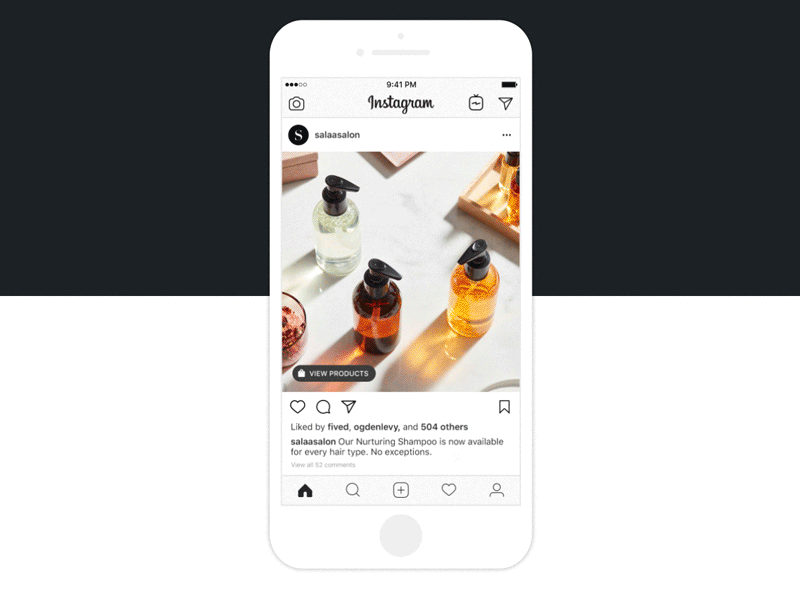Digital marketing is not the only thing that is changing. The way people consume content today is vastly different from a few years ago. This is why as a content marketing agency, we’re continually keeping up with consumer needs and digital marketing trends to create and distribute effective content.
If you’re looking to get ahead in this competitive marketing landscape, here are 6 digital marketing trends in 2020 you need to know and hop on to if you haven’t already done so.
6 digital marketing trends from a content marketing agency
1. Social commerce & shoppable posts

Image credit: squareup.com
What it is
We have recently seen the transformation of social networking platforms into full-scale sales channels.
Instagram, for instance, has blended marketing and social commerce via a new Instagram Shoppable feature. Brands can sell products directly within the Instagram app by tagging products in their posts. Viewers can then tap, view, and purchase.
The same goes for Facebook, which introduced Facebook Buy buttons that enable one-click-to-buy functionality. Shipping details entered into the app will be auto-saved and auto-filled for subsequent purchases.
To complete the digital shopping experience, these social commerce platforms would update customers on the shipping and delivery status via app notifications. This enables customers to track purchases without leaving the app.
How your brand can leverage this digital marketing trend
Social networks are already instrumental in providing brands with a place to engage its audiences, and today, these networks are becoming their own self-contained online marketplaces.
Social commerce does not mean a complete shift from social content marketing to e-commerce. Instead, social commerce will complement and strengthen your content marketing strategy.
This is because these “shoppable posts” blur the line between social media and e-commerce, making it easier for customers to buy products directly without leaving the app.
This means that your customers will stay engaged with your digital content for a longer time.
2. Interactive content

Image credit: buffer.com
What it is
Interactive content is one of the emerging digital marketing trends that allows brands to create unique, digital experiences for their customers. Content marketing services like interactive content usually involve quizzes, polls, augmented reality (AR), and 360-degree videos.
For instance, if you have just launched a new concept cafe, you can create a virtual tour online, or enhance visitors’ stay in your cafe through AR.
The Central Provident Fund (CPF) Board is an example of an organisation that has made efforts to introduce interactive content via mini-games on Instagram stories. In this story titled “Are your expenses too much to digest?”, users are invited to tap on three caterpillars who are chewing on leaves aggressively.
The key message relates to financial planning, where users are encouraged to spend within their means and “flutter away from the cocoon of overspending”.
How your brand can leverage this digital marketing trend
Interactive content has become a new category of digital marketing, with many brands and content marketing agencies experimenting on it.
With interactive content, customers get to enjoy an immersive brand experience and participate in your brand. Today’s consumers are increasingly expecting interactivity, instead of links that direct followers to your typical blog posts or YouTube videos.
To monitor the performance of your interactive content, evaluate the number of social shares and session times instead of click-through rates.
3. Video and live streams

What it is
Live events such as talks, presentations, and demos have been streamed online to provide an unscripted, authentic experience.
Besides connecting with audiences at a personal level, live streaming allows you to conduct social listening.
For instance, a brand may have started live streaming with a behind-the-scenes tour of its operations. As viewers chime in with more and more questions, the conversation will naturally swing to what viewers want to discuss, and this could range from the price of a product to its features.
As content is shared live, there’s no need to over-produce and over-script as you would for a high-quality marketing video. The purpose of live streaming is to allow audiences to get to know who you are.
How your brand can leverage this digital marketing trend
As a content marketing strategy, live streaming allows you to create conversations with your audiences in real-time. It is different from the usual marketing videos that tend to create passive, one-sided viewing experiences.
Brands and content owners can learn a lot from their audience based on the questions they ask. Live sessions can bring a lot of value to viewers too as they will be tailored to their interests. Live streaming will thus boost customer interaction and grow your online brand presence.
4. User-Generated Content (UGC)

What it is
User-generated content is simply content that is created by your users, followers, or audience. User-generated content can be in any form and can include reviews, blog posts, photos, and testimonials.
Since customers trust each other more than they trust brands, user-generated content can make a positive influence on your followers, and spur conversion.
If done well, user-generated content can turn followers and customers into advocates for your brand.
How your brand can leverage this digital marketing trend
User-generated content is increasingly popular among content marketers as it offers an original perspective for brands and their products and services.
User-generated content acts as social proof for your brand, instilling trust and strengthening relationships with your followers.
By leveraging on user content, you get to save time and effort since content creation is effectively outsourced.
5. Podcast

What it is
Podcasts are audio episodes that are streamed over the internet on demand. Podcasts are specific in terms of their topics, and are intended to appeal to people with niche interests.
For instance, there may be podcasts dedicated to a city’s hip-hop scene, content marketing trends, or even taboo topics.
As podcasts are perfect for listening during the daily commute, they’re quickly growing in popularity. Content marketing agencies and digital marketers are beginning to see the power of this audio format in helping them form a connection with their audiences.
How your brand can leverage this digital marketing trend
Podcasts are cost-effective ways of positioning your brand as an authority in a particular field and to expand your audience reach.
Podcasts with valuable content will keep loyal followers who will stick around and catch up on episode after episode. Your brand can even interview subject matter experts, create polls beforehand, or even answer frequently asked questions to make the listening experience more interactive and valuable for your audience.
Learn more about podcasts as a content marketing tool here.
6. Alternate Search Engines

What it is
Though Google has been a dominant search engine, it has been criticised for search manipulation, aggressive advertising, and sharing browsing data with advertisers.
This is why informed consumers who are unwilling to trade privacy for convenience are turning to alternative search engines such as Yandex, DuckDuckGo, Search Encrypt, and giveWater.
DuckDuckGo, in particular, has gained popularity among like-minded users who wish to protect their search privacy. Here are the other pros and cons of using DuckDuckGo:
| Pros | Cons |
| Does not track or store any information on its users or their searches | Lacking in features such as Google Maps, Google Books, Google Flights etc. |
| Clean interface and simple user experience | Each user will get the same search results no matter which part of the world they’re at as there is no targeting |
| Increasing in popularity, which translates into more profits and resources going into improving the search engine | Need to enter more specific queries to get the best search results |
How your brand can leverage this digital marketing trend
Since alternate search engines are increasing in popularity among users who value their privacy, brands can benefit from search visibility on such new platforms.
Competition for the same keywords is less fierce on these alternate search engines, allowing you to leverage search engine optimisation and grow organic online traffic.
Wondering how to find the right keywords for your business? Learn more about it here.

